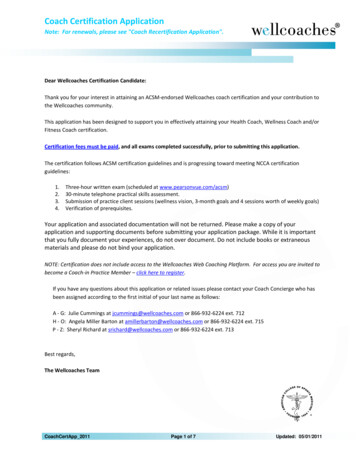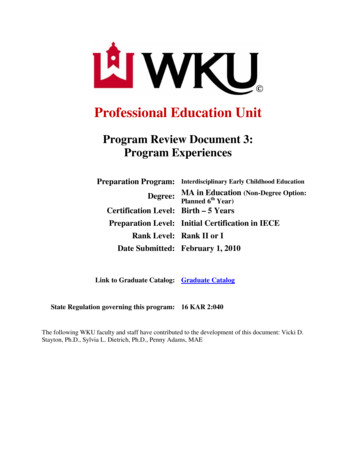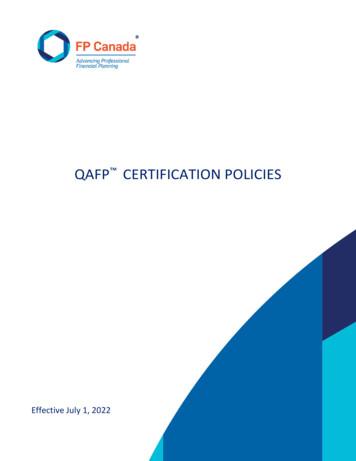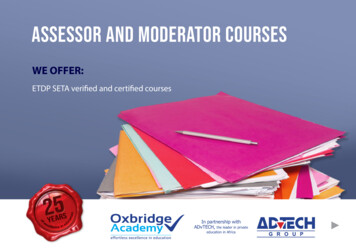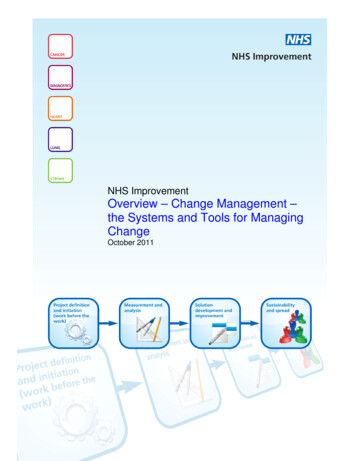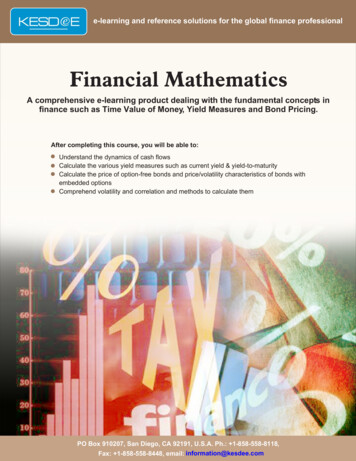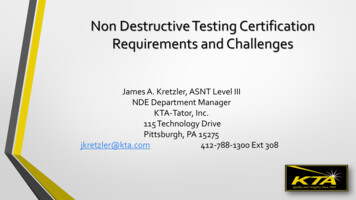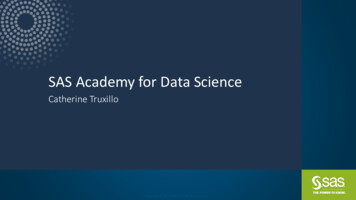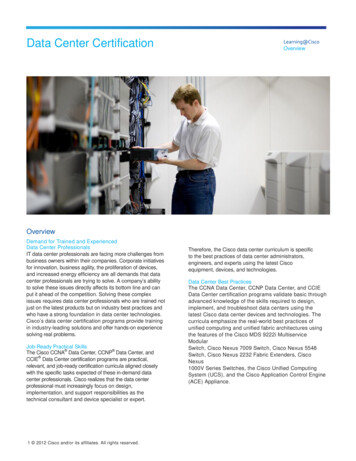
Transcription
Change management certificationcourses from APMG and Prosci .Which one is right for you?By Chris Moore, Director for Aspire’s consulting services andRobert Cole Managing Director for the Centre for Change Management (C4CM)
APMG and Prosci Change Management Certification programmesExecutive SummaryBoth APMG and Prosci offer certification programmes for people seeking to knowmore about change management. In the recent times, these are increasingly seen asalternatives or competitors and many potential candidates want to know how theseoffers differ. The APMG course content covers many of the foundation theories thatunderpin today’s change management practice, as well as some practical approachesthat candidates can use on change initiatives. The Prosci course offers training onProsci’s research-based methodology and toolkit; which enables candidates to developtheir change management plans during their attendance on the course.Key distinctions of APMG Broader learning of background and theories supportingthe discipline of change management based on a Body ofKnowledge Rigorous exam and certification process Greater emphasis on passing the exam Alignment of content to a professional body Authorised Training Providers (ATP) may use their owntraining material, accredited by APMG The course may be offered as an eLearning option, includingan on-line examKey distinctions of Prosci Learning is focussed on the Prosci proprietary methodologyand supporting tools Attendees develop their change management plan on the course Prosci method is research-based and internally consistentIt is the view of the authors that these two courses are morecomplementary than competitors. APMG is strong on theoryand the body of knowledge; the “why” and “what”. Prosci isstrong on practice and application; the “how”. If both coursesare taken they would offer valuable, additive learning for thechange management professional.The APMG course is a broad high-level introduction of theoryand ideas about change management; suitable for someonestarting in the field or a self-taught manager looking for somenew ideas and thinking tools to improve their approach tothe complex problems in change. The Change Managementcourse comprises of two levels; Foundation for those whoare starting in the role as change managers or are involved inimplementing change in organisations. The practitioner levelis for experienced change managers involved in initiatingchange and executing it across programs and projects. TheProsci course is ideal for someone who is facing a changesituation and wants to know what to do and when; it is aboutthe process of change in the organisation and for individuals. Training fee includes a lifetime licence to use the Prosci eToolkit ATPs use Prosci training material and hand-outs The course and exam are face-to-face only Prosci can be used in teams and facilitates teams to dealwith challenging situationswww.apmg-international.com/ ı 07/20172
APMG and Prosci Change Management Certification programmesIntroductionThis paper has been produced in response to a request from APMG for a white paperthat would help potential customers understand how the two certifications compare.The purpose of this paper is to provide an objective comparison of the changemanagement certifications offered by APMG and Prosci. It has been co-authored byChris Moore, an Advanced Prosci Instructor at Aspire Europe, and Robert Cole who isAspire’s Lead APMG Change Management Trainer and contributor to the APMG coursetext (see Annex B).Background to APMG Change ManagementcourseThe APMG Change Management course is offered as a 3-dayFoundation and 5 day Practitioner course. The current coursecontent (a formal syllabus) is selected from the EffectiveChange Manager’s Handbook1, which covers the scope of theChange Management Institute’s (CMI) Body of Knowledge.Originally the course was developed around the content of thebook by Esther Cameron and Mike Green; Making Sense ofChange Management.The Effective Change Manager’s Handbook, summarises a rangeof well- established change management theories and combinesthem with best-practice approaches and techniques that offerthe practitioner some practical tools-for-the-job. The coursesyllabus selects a small subset of these theories and bestpractice for examination.Background to Prosci Change ManagementcoursesProsci is a research tool and methodology development,advisory services and training organisation based in FortCollins, Colorado, established by Jeff Hiatt 22 years ago toundertake research into change management practices. Theyoffer a range of role-based change management courses, usingsimilar core material which is drawn from their own researchbased methodology and content. 3-day Change Management Certification programme* ½ day Sponsor briefing 1 day Manager programme 1 day Project Managers programme ½ day Employee orientation programme 1 day Enterprise Change Management boot camp 3-day Experienced Practitioner programme 2-day Advanced Immersion Workshop 4 day Train the Trainer programmeFor the purposes of this paper a comparison is drawn betweenProsci’s 3 day Change Management certification programme*and the APMG 5 day Practitioner course. However, it is worthnoting that Prosci’s Experienced Practitioner Programme foradvanced practitioners is probably more closely aligned withAPMG’s course content, but this programme is rarely availablein the UK.Prosci have developed their own proprietary methodology;a structured, tailorable model for managing change at theorganisational level. This is supported by ADKAR , a wellknown model for managing individual change that is alsocovered in the Change Manager’s Handbook. Prosci’smethodology is based upon the same well-known theoriesthat are presented on the APMG course and in addition theyhave drawn from their own research; a biennial, methodagnostic study which is published as Best Practices in ChangeManagement2. The Prosci methodology is supported by anon-line eToolkit, which contains the diagnostic and assessmenttools, plus templates and guidance, for use by changepractitioners on actual projects. The course fee includes anindividual, lifetime licence to use the eToolkit.Comparing APMG and ProsciComparing course designThese courses have some significant differences: Candidates on the Prosci course will submit pre-work basedupon an actual change project they are working on and theywill be taught to apply Prosci’s change management tools tothat project. During the course, they will develop their changemanagement plans, culminating in a presentation to theother candidates or their sponsor. The Prosci course is verypractical and specific to Prosci’s methodology. The APMG course is wide-ranging and more theoretical,drawing material from notable change management writersand teaching candidates to consider a variety of techniquesand tools through exercises and a case study. APMG’s courseis not method-specific. In many markets, the Prosci public courses are residentialwith evening activities designed to get to know the candidatesas well as to continue with project work and presentations.(On-site, client specific courses do not require the residentialapproach.) It is worth noting, that when the course is run as aclient specific course, project sponsors are invited to attendevening presentations of their team’s change managementplans. The APMG course focusses on the exam and examinablematerial; exercises and use of a case studies vary betweendifferent ATPs.1 The Effective Change Manager’s Handbook The APM Group Limited 20142 Best Practices in Change Management 2016 Prosci Inc.www.apmg-international.com/ ı 07/20173
APMG and Prosci Change Management Certification programmesComparing contentA detailed comparison of the content of both courses is providedat Annex A. This shows that there are many similarities inthe content covered, although in some cases the underlyingapproach and content is quite different.The APMG content differs from Prosci in the followingkey areas:a) Theories and models that underpin change managementbest practice such as Kotter, Lewin, Bridges, Herzberg,Maslow, etc. The break-out exercises encourage participantsto consider this learning and apply it in practice to thedevelopment of their change management interventions.b) Topics which are not explicitly covered by Prosci include;1. motivation,2. learning styles,3. culture,4. change definition,5. vision,6. the change agent network.c) Stakeholder mapping and analysis techniques. (Proscifocusses on the sponsor coalition and middle managers.)The Prosci course draws a lot from Prosci’s own research; thisdata and the associated insights distinguish Prosci’s approach.It takes a much lighter approach to the development of changemanagement thinking and supporting theories.The Prosci content differs from APMG in the followingkey areas:a) Prosci’s research on change management and the lessonsthat can be learnedb) The course covers in more detail the engagement of sponsorsand middle-managers, how to assess the sponsorshipcoalition, including competency assessments for key changemanagement roles.c) Training to use ADKAR is a significant moduled) The course is structured around the five CM plans(sponsorship, line manager coaching, resistance, trainingand communications) which candidates build during theirattendance.e) The eToolkit includes risk assessment, readiness assessmentand a comprehensive impact assessment, as well as AKDAR results. The use of and licence for this toolkit is anotherdistinguishing feature.Comparing lifecyclesProsci 3-Phase project lifecyclePHASE 1.PREPARING FOR CHANGEPHASE 2.MANAGING CHANGEPHASE 3.REINFORCING CHANGEDefine your changemangement strategyDevelop changemanagement planscollect and analyze feedbackPrepare your changemanagement teamTake action andimplement plansDiagnose gaps andmanage resistanceDevelop yoursponsorship modelImplement corrective actionsand celebrate successsMain ActivitiesMain ActivitiesMain Activities Conduct readiness assessments Create plans for Proactively collect feedback and listento employees Reform risk analysis- Communications Anticipate resistance areas- Sponsorship Design special tactics- Coaching Develop overall strategy- Training Architect team structure- Resistance management Audit compliance with "new way ofdoing things" Identify gaps and areas or resistance Prepare your team Integrate into project plan Assess sponsorship Execute plans Implement corrective action Celebrate successes Move to "new" business as usualAt the top level these lifecycles look very similar, but there are two key differences:1. APMG stage one, relating to change drivers and vision,is not included in the Prosci lifecycle, which assumes thatthe change has already been defined. In practice, of course,change is often weakly defined and justified.www.apmg-international.com/ ı 07/20172. The Prosci course uses the lifecycle as its agenda, with theattendees completing each step and sub-step for their ownproject, using Prosci’s assessment tools and the eToolkit.4
APMG and Prosci Change Management Certification programmesAPMG lifecycleGeneric Change Process1. IDENTIFY2. PLAN3. DELIVER4. EMBEDStrategy/DriversMetaphorsOrganizational CultureChange ModelsChange RolesChange visonChange ImpactChange AgentnetworksChange TeamChange ReadinessResistanceWhat is to be learnedProgramme andProject ManagementChange AdoptionChange LeversSustaining ChangeReinforcing SystemsChange NetworksSTAKEHOLDER ENGAGEMENT AND COMMUNICATIONSPrinciples, Identification/Segementation, stakeholder Personas, Stakeholder MapsCommunication Biases, Approaches, Channels, Planning CommsCHANGE AND THE INDIVIDUALLearning Process and Styles, Learning 'Dip', Models of Individual Change,Motivation, Individual DiffrenceComparing certification and operating arrangementsWith respect to course material:With respect to practitioner certification:1. For Prosci courses this is provided by Prosci, not by the ATPas in the APMG model. Many affiliates ship the material fromthe USA and others print the material locally, particularly whenusing translated material which includes: Arabic, French,French Canadian, German, Portuguese, Polish, Russian andSpanish.1. The APMG course has a more rigorous approach tocertification. It includes over 3 hours of exam time to achievePractitioner certification using objective testing. A primaryobjective of the course is to achieve certification, with theoption to stop at the Foundation level (40 minutes examtime). If both Foundation and Practitioner Exams are passedthen the candidate will automatically pass the Knowledgecomponent of CMI’s Foundation level accreditation.2. The Prosci course is focussed on the learning experienceand the exam is less rigorous, with other factors being relevantto the certification, including the quality of project work andthe presentation. The exam is 20 minutes multiple choice;perhaps best seen as a reinforcement device, although Proscihave strengthened the questions and marking process inrecent years. Certification entitles candidates to credits withthe Project Management Institute, the Association of ChangeManagement Professionals and the HR Certification Institute.Certified candidates will also automatically pass the Knowledgecomponent of CMI’s Foundation level accreditation.2. For the APMG course the slide set design and exercises areundertaken by the individual ATP; to encourage competitionamongst ATPs. APMG sets the syllabus that must be coveredby ATPs and then certifies the APT material.Both APMG and Prosci have a network of ATPs and apply rigourto the qualification and appointment of these providers. Proscialso appoints regional Primary Affiliates, only one per region/nation. Primary Affiliates are the only providers authorised to runopen-enrolment courses, which limits the public availability ofProsci courses.Although Prosci’s certification process is less rigorous it isworth noting that Prosci apply tight control on the quality of thelearning experience with less delegation to the ATPs than thatallowed by APMG.With respect to instructor certification:1. The Prosci instructor qualification process requires a 4 daytrain-the-trainer course (mostly only available in the USA),followed by an audit which involves a Prosci auditor sitting inthe training room for the full 3 days.2. An APMG trainer must pass the practitioner exam with ahigher pass mark as well as pass a product knowledge testand is observed by an APMG assessor delivering part of acourse.www.apmg-international.com/ ı 07/20175
APMG and Prosci Change Management Certification programmesAnnex A: course syllabus comparisonAnnex A: course syllabus comparisonAPMG Change Management SyllabusProsci Change Management SyllabusThe Change Management Perspective Learning and the individual- Learning process and styles- Learning Dip Key rolesChange Agents not in ProsciDrivers of changeDeveloping visionStakeholder strategyCommunication and engagementChange ImpactChange readinessPreparing for resistanceTraining planningProject managementSustaining change- Connecting change to business results- Mitigating negative consequences- Speed of adoption, utilizationand proficiencyProsci Change Management researchADKAR – model for individual changeProsci Change Management methodologyChange and the organization- Metaphors- Culture- Models of change- Emergent change Why is Change Management important mostly Change and the Individual- Models- Motivation- Individual differencesProsci Project Change Triangle (health check) Change conceptsChange Management & Project Management Preparing for Change- Readiness assessments- Risk analysis- Group Impact assessments- Change team- Governance/sponsor model- Change Management Strategy- Sponsorship coalition assessment Managing Change- Comms plan- Sponsor Roadmap- Manager coaching plan- Resistance Management plan- Training planKey:Evening presentation of CM plans to sponsor Topic covered in both, content may vary Topic not covered in bothReinforcing change Annex B: about the authorsChris MooreRobert ColeA Director for Aspire’s consulting services, Chris is a practisingprogramme manager and an Advanced Prosci Instructor who hasbeen delivering Prosci courses for over 5 years. He has run over20 public and private 3-day certification programmes, as wellas numerous Sponsor Briefings and Manager programmes. Inaddition to teaching the Prosci methodology, Chris has extensiveexperience of the practical application of Prosci to managechange on major transformation programmes.Managing Director for the Centre for Change Management(C4CM) and Aspire’s Lead Trainer for the APMG ChangeManagement course. Rob was also a contributing author for TheEffective Change Manager’s Handbook and lead author of thecourse content for Aspire’s APMG accredited course material.As well as training, Rob has extensive experience of managinginformation technology, business strategy and innovation.Special thanks to Mark Dorsett, VP Global Business and StrategicPartnerships, PROSCI and to Jo Harland and Karla Micallef of theChange Management Institute.FOLLOW US ONLINE@APMG m
The purpose of this paper is to provide an objective comparison of the change management certifications offered by APMG and Prosci. It has been co-authored by Chris Moore, an Advanced Prosci Instructor at Aspire Europe, and Robert Cole who is Aspire's Lead APMG Change Management Trainer and contributor to the APMG course text (see Annex B).
![Change Management Process For [Project Name] - West Virginia](/img/32/change-20management-20process-2003-2022-202012.jpg)
